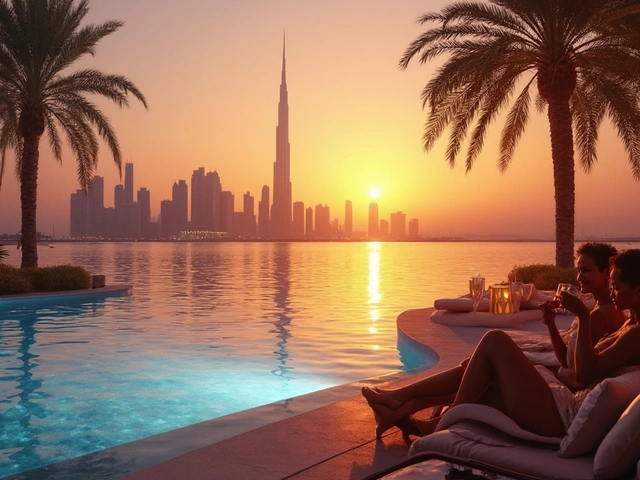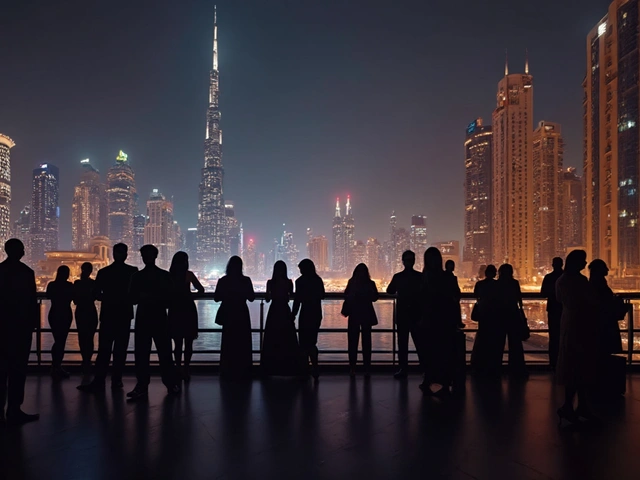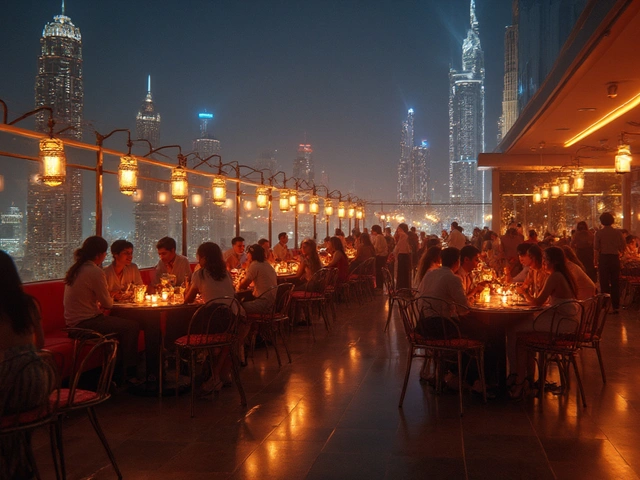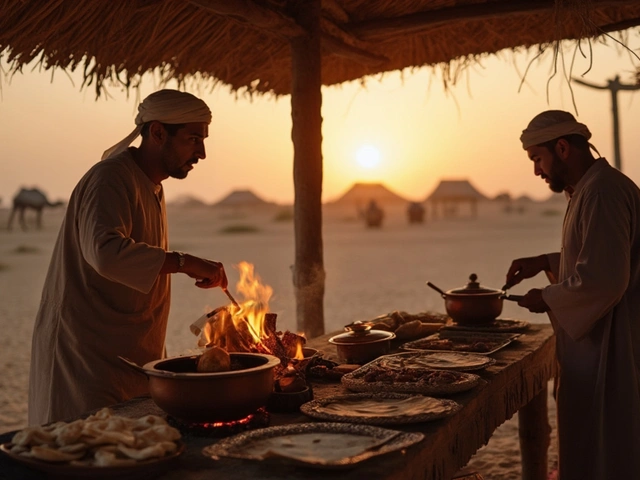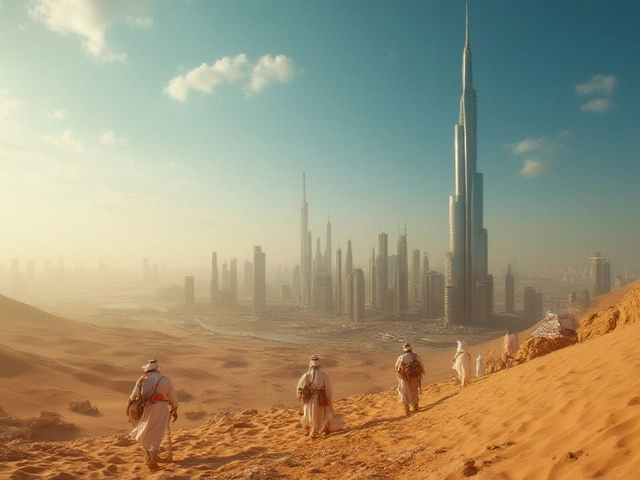When people think of Dubai, they usually picture the crazy futuristic skyline, giant shopping malls, or beach clubs. But there’s a whole other side hiding in plain sight—the historical sites in Dubai that give you a real taste of the city before it became a global hub.
If you want more than just selfies with the Burj Khalifa, put Al Fahidi Historical Neighbourhood on your list. Here, you’ll see old wind-tower houses, narrow lanes, and traditional cafés selling karak tea. It’s a quick break from the AC-filled malls and lets you walk through what Dubai was like decades ago.
Skip the guesswork: use the Dubai Culture app to get maps, event updates, and even audio tours. Most places, like the Dubai Museum inside Al Fahidi Fort, are family-friendly and cost way less than most tourist attractions. Fridays can get busy with school trips and visitors, so go in the morning if you want peace and quiet.
- Dubai's Old Neighbourhoods: Stepping into the Past
- Must-See Landmarks and Hidden Gems
- Cultural Experiences You Can't Miss
- Navigating Heritage Spots: What You Need to Know
- Best Times and Ways to Explore
- Tying Dubai's Past to Today
Dubai's Old Neighbourhoods: Stepping into the Past
Most folks rush straight to the skyscrapers, but the real stories of Dubai are found in its oldest corners. The Dubai historical sites you actually want to see are right around the Creek—places like Al Fahidi Historical Neighbourhood and Al Shindagha.
Al Fahidi is one of the best-preserved pockets of old Dubai. Back in the early 1900s, this place was packed with traders, pearl divers, and local families. When you walk around, you’ll spot restored wind towers because AC didn’t exist, and these clever rooftops channeled cool air into the houses. You can check out art spaces, the Coffee Museum, and the Sheikh Mohammed Centre for Cultural Understanding (SMCCU)—all within a few steps.
Al Shindagha, just across the water, is where you’ll find the recently updated Shindagha Museum. It covers everything from the city’s early days to the rise of its ruling families. Plus, don’t miss the chance to take an abra—one of those old wooden boats—to cross Dubai Creek for about 1 dirham. It’s quick, cheap, and way more fun than another car ride.
The Dubai Culture & Arts Authority says, “Preserving our neighborhoods is not just about protecting buildings—it's about keeping memories alive for future generations.”
If you’re short on time but want a taste of tradition, hit up these spots:
- Walk through Al Fahidi’s alleys and pop into XVA Art Hotel for a coffee break.
- Book a cultural meal at SMCCU where locals will answer any question you have—no matter how awkward.
- Time your visit for the annual Sikka Art Fair in Al Fahidi, where local artists transform old houses with modern art.
Bring a camera and some cash—lots of cafés and museums in these neighborhoods take cards, but small vendors might not. You’ll also want to wear something modest and light. The shaded lanes help, but Dubai heat is no joke, especially between May and September.
Must-See Landmarks and Hidden Gems
Some historical places in Dubai are so well-known that locals and tourists both keep coming back. But there are also a few underrated spots that even people living here might not know about. Here’s where the real stories hide.
First up, the Dubai Museum in Al Fahidi Fort should always be at the top. It’s inside the oldest building in Dubai, built way back in 1787. You’ll spot everything from pearl diving gear to old maps showing the city before the skyscrapers and metro lines.
Don’t skip Jumeirah Mosque, one of the only mosques in Dubai open to non-Muslims. The guided tours are casual, friendly, and all questions are welcome. It’s a cool way to see what real Islamic architecture looks like up close.
Now, if you want something less obvious, start at Saruq Al Hadid Archaeology Museum in Shindagha. The site behind this place dates back over 3,000 years. You’ll find artifacts that prove Dubai’s links to ancient trade—all discovered in the middle of the desert by a local ruler flying his helicopter (seriously, look it up). The interactive displays are fun for kids and adults.
Another spot that’s a little under the radar is Al Shindagha Heritage Village. It’s newly renovated and packed with old Dubai houses, spice shops, and even a perfume museum. If you like hands-on stuff, this is the place—sometimes they offer live cooking, weaving, or even dhow-building workshops.
- Etihad Museum: The perfect stop for history buffs wanting to know how the UAE was formed in 1971. It’s modern, well laid out, and all signage is in both English and Arabic.
- Al Ahmadiya School: Dubai’s first school, now a micro-museum, tucked away in Deira. It’s quick to visit but gives you a real sense of the city’s first step towards modern education.
If you’re planning to squeeze a few places into one day, check this out:
| Site | Location | Entry Fee | Best Time to Visit |
|---|---|---|---|
| Dubai Museum | Bur Dubai | AED 3 (adults) | Morning/Weekdays |
| Jumeirah Mosque | Jumeirah Beach Rd | AED 35 (includes guided tour with tea) | 10:00 AM (tour time) |
| Saruq Al Hadid Museum | Shindagha | AED 20 | Afternoon |
| Al Shindagha Heritage Village | Shindagha | AED 15 | Late Afternoon |
| Etihad Museum | Jumeirah | AED 25 | Evenings |
| Al Ahmadiya School | Deira | Free | Anytime |
Most of these places are easy to reach by Metro or Careem. Fridays can get crowded with group tours, so aim for weekday mornings for a quieter experience. And don’t forget—many sites close midday for prayer or lunch breaks, so double-check the timings before you go.
Cultural Experiences You Can't Miss
If you’re aiming to really connect with Dubai’s past, nothing beats getting hands-on with local traditions and experiences. The city is packed with practical ways to see what life was like before skyscrapers and luxury cars took over.
First up, don’t miss the Dubai historical sites that give you front-row seats to Emirati life. Stop by Al Bastakiya for a calligraphy workshop, or sign up for a guided heritage walk. Local guides share stories that you won’t find in guidebooks.
- Al Seef: This spot along Dubai Creek mixes old and new. Check out the souks, try Emirati snacks like luqaimat (sweet dumplings), and explore old wooden dhow boats.
- Sheikh Mohammed Centre for Cultural Understanding: Book a traditional Emirati breakfast, listen to locals share their stories, and ask whatever you want about Emirati customs—no question is off-limits here.
- Jumeirah Mosque: Open to non-Muslims, this mosque does daily guided tours where you can learn about Islamic culture and architecture. Dress modestly and get there a few minutes before the 10AM start.
The city’s cultural festivals are another must. Dubai hosts Sikka Art Fair in Al Fahidi every March. It’s your chance to catch local artists, music, and some wild street food pop-ups. Plus, during UAE National Day (December 2), historical sites go all out with decorations, folk dances, and free-entry days.
If you’re a food lover, try local Emirati restaurants like Al Khayma Heritage Restaurant in Al Fahidi for machboos (spiced rice and meat) and camel milk ice cream. Trust me, even picky eaters find something interesting here.
| Experience | Location | Cost (AED) | Timing |
|---|---|---|---|
| Guided Mosque Tour | Jumeirah Mosque | Free | 10:00 AM daily |
| Emirati Breakfast | SMCCU | 69 | Mon-Thu, 9:00 AM |
| Art Festival Entry | Al Fahidi | Free | Every March |
| Heritage Walk | Al Bastakiya | 30 | Weekends, 4:00 PM |
For the best experience, book ahead for special tours and bring cash—some smaller vendors don’t accept cards. Dress cool but modest, and always double-check timings since holidays can mean schedule changes. Dive in with an open mind and you’ll see a whole new side of the city that’s way more authentic than your typical tourist traps.

Navigating Heritage Spots: What You Need to Know
Getting around Dubai’s historical sites is way easier than you’d think, but there are a few tricks to make sure you get the most out of your trip. First off, a ton of these places sit pretty close to each other in Bur Dubai and the old Deira area. Al Fahidi, the Dubai Museum, the Coffee Museum, and the Textile Souk are all walking distance. Wear comfy shoes—you’ll actually want to walk.
Transport is sorted in this part of town. Dubai Metro’s Green Line has you covered, with Al Fahidi and Al Ghubaiba stations close to the action. If you’re going old-school, try the abra ride across Dubai Creek. It costs only AED 1 each way and gives you awesome views of the old trading port.
- Entry fees for most heritage sites are low. For example, the Dubai Museum in Al Fahidi Fort is only AED 3 for adults and AED 1 for kids under 6.
- Most sites open from around 8 AM to 8 PM, but note that hours may change during Ramadan or public holidays.
- Dress codes matter, especially at places like Jumeirah Mosque. Shoulders and knees should be covered, and women usually need a scarf for their hair.
- Many historical places have guided tours—often free or for a small fee. For example, the Sheikh Mohammed Centre for Cultural Understanding offers a cool walking tour with local guides who’ll answer anything you throw at them about culture and traditions.
- Photography is normally allowed, but always ask at private homes or less touristy spots. Locals appreciate the respect.
Here's a quick look at essential info for a few major Dubai historical sites:
| Site | Nearest Metro | Opening Hours | Entry Fee |
|---|---|---|---|
| Al Fahidi Historical Neighbourhood | Al Fahidi | 24/7 (outdoors); Museums 8 AM–7:30 PM | Free (outdoors) |
| Dubai Museum (Al Fahidi Fort) | Al Fahidi | 8:30 AM–8:30 PM (Fri 2:30–8:30 PM) | AED 3 adult, AED 1 child |
| Jumeirah Mosque | None direct; Taxi from Emirates Towers | Sat–Thu 10 AM tour; Closed Fri | AED 35 (with tour, includes snacks) |
| Sheikh Saeed Al Maktoum House | Al Ghubaiba | 8 AM–8:30 PM | AED 3 adult, AED 1 child |
If you drive, parking is tight near the old souks—try RTA-paid lots or the multi-level car parks. Taxis and Careem are everywhere if you want to skip the hunt altogether. Lastly, don’t rush. The stories, friendly stall owners, and smells from the spice souk all add to the experience. Give yourself time, grab a coffee, and chat with locals.
Best Times and Ways to Explore
Dubai's weather can be a deal-breaker when it comes to checking out Dubai historical sites. December to March is when the city feels the nicest—expect daytime temps between 19°C and 25°C. Humidity is lower, and you can actually walk outdoors without melting. If you’re heading out during the summer, try going early in the morning or just before sunset. Many sites like Al Fahidi close by 8 PM, so plan accordingly.
Getting around is actually pretty simple. Dubai Metro is clean, reliable, and stops near spots like Al Ghubaiba (for Al Fahidi and Dubai Museum) or Al Ras (for Gold and Spice Souks). Taxis are everywhere and cheap compared to some other big cities. Don’t forget Careem or Uber—some places even have Careem e-bikes outside!
Here’s a handy cheat sheet:
| Site | Best Time to Visit | Nearest Metro | Entry Fee (AED) |
|---|---|---|---|
| Al Fahidi | Before 11 AM | Al Fahidi | Free |
| Jumeirah Mosque | 9:45 AM (Guided Tour) | Al Jafiliya | 35 |
| Dubai Museum | 10 AM - 1 PM | Al Fahidi | 3 |
| Sheikh Saeed Al Maktoum House | Afternoons, weekdays | Al Ghubaiba | 15 |
Don’t want to go solo? Tours run by Dubai Culture or Desert Adventures cover all the big spots and even throw in fun facts you’d never get from Google. Book a small group—keeps things personal, and you won’t get shuffled around like cattle.
If you’re fasting during Ramadan, remember most heritage areas are quieter and may close earlier. But it’s the perfect time to see Dubai’s traditions up close. One regular visitor, Mariam Al Marashda, says,
“You really get to feel the soul of the city in the older quarters, especially after Iftar when the streets come alive with families.”
Just wear comfy shoes, carry water, and keep a light scarf if you want to step into mosques. You’ll avoid awkward moments and stay cool when things heat up.
Tying Dubai's Past to Today
It’s pretty wild how you can go from a 200-year-old fort straight into skyscraper central within minutes in Dubai. That’s intentional. The city doesn’t want to leave its roots behind, and that makes exploring Dubai historical sites so unique. You see how old trading values, hospitality, and architecture still sneak into daily life here.
Take the way Dubai handles its traditional souks. Even today, the Gold Souk and Spice Souk in Deira carry on the same hustle and noise you would have found when pearl divers ruled the markets. Sellers are still eager to bargain, and you’ll spot products stacked in a way that hasn’t changed in generations.
Then there are modern buildings inspired by classic designs. The Arabian-style arches of Madinat Jumeirah, for example, mix old wind tower vibes with new resort comfort. Even in new spots, you’ll see mashrabiya wooden screens popping up, which go way back as a way to get breeze while keeping private.
Dubai prioritizes heritage events too. The annual National Day parades near Dubai Creek, or the Ramadan Iftar tents in old neighborhoods, are a mashup of tradition and today’s pace. It’s a deliberate way to keep locals, expats, and tourists aware of where the city’s character comes from.
Here are a few examples of how old-school Dubai still shows up in modern life:
- Arabic coffee and dates at government offices—serving guests is still a must.
- Falconry festivals like the one in Nad Al Sheba, celebrating the old desert lifestyle.
- Government preservation: The Dubai Municipality lists more than 600 protected heritage sites as of 2025.
| Old Dubai Influence | Modern Counterpart |
|---|---|
| Abra boats on Dubai Creek | RTA Water Bus |
| Street-side majlis gatherings | Community tent events during Ramadan |
| Traditional wind towers | Designs in business hotels and malls |
The bottom line—Dubai pushes forward at full speed, but it refuses to forget where it came from. If you live here or just visit, checking out the historical spots isn’t just a box-tick; it’s the shortcut to understanding today’s Dubai.


